In Short:
Performed a year before the release of the Revue Starlight anime, the first Revue Starlight stage play tells a similar story complete with some familiar songs and fun choreography. This stage play is notable because the nine core live action stage actresses went on to voice their same roles in the anime.
Though it may just be an unfortunate trick of the camera, a lot of the projected graphics used for character introductions and magical combat effects appear to be very dim in the DVD / Blu-Ray version of the play and are not as impactful or as easy to see as they might have been when viewed in person.
Full Review:
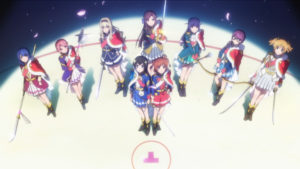 I’ve come to love Revue Starlight, the anime. It combines fun characters, great music, and a strong appreciation of the stage to create an outstandingly unique show. But, Revue Starlight is more than just an anime. At this point, it’s a moderately large multi-medium franchise that includes: Three multi-volume manga, a single cour anime along with an upcoming followup movie, at least four live action stage plays, and an ongoing mobile game that continues to add new stories. It’s the first of these stage plays I’d like to focus on today.
I’ve come to love Revue Starlight, the anime. It combines fun characters, great music, and a strong appreciation of the stage to create an outstandingly unique show. But, Revue Starlight is more than just an anime. At this point, it’s a moderately large multi-medium franchise that includes: Three multi-volume manga, a single cour anime along with an upcoming followup movie, at least four live action stage plays, and an ongoing mobile game that continues to add new stories. It’s the first of these stage plays I’d like to focus on today.
First showing in 2017, “Shōjo Kageki Revue Starlight: The LIVE #1” tells a similar story to the anime where nine stage girls fight in magical Revues in order to try and win the position of the Top Star of their music academy’s 99th class. I wasn’t exactly sure what I was getting into when I decided to watch the stage play. Would it be the same story as the anime but stuck on a more limited stage? Would it be a condensed, unfinished, prototype version of the anime? Would it be a different story altogether? It turns out, it’s actually pretty good on its own merits while still being similar to the anime.
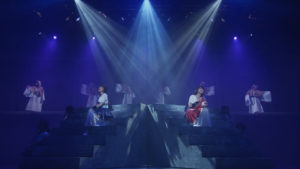 The play opens with our two main characters, Karen and Hikari, as children enjoying the pivotal, tragic scene of the in-universe Starlight stage play. We learn about the two’s promise to become stars of the stage together and of their abrupt childhood parting. We then cut to several years later and are introduced to the eight main member’s of Seisho Music Academy’s 99th class. Each is a different personality and each gets a fun self-sung musical introduction to let the audience know who they are and what they are about. From the proper, rules-following class representative Junna, to the egotistical Maya and Claudine, to the shy Mahiru and Banana, to the larger than life Kaoruko and Futaba, each character rings true. It’s only later that our lead character, Karen, is found sleeping in a separate classroom. Her musical introduction was especially fun and silly!
The play opens with our two main characters, Karen and Hikari, as children enjoying the pivotal, tragic scene of the in-universe Starlight stage play. We learn about the two’s promise to become stars of the stage together and of their abrupt childhood parting. We then cut to several years later and are introduced to the eight main member’s of Seisho Music Academy’s 99th class. Each is a different personality and each gets a fun self-sung musical introduction to let the audience know who they are and what they are about. From the proper, rules-following class representative Junna, to the egotistical Maya and Claudine, to the shy Mahiru and Banana, to the larger than life Kaoruko and Futaba, each character rings true. It’s only later that our lead character, Karen, is found sleeping in a separate classroom. Her musical introduction was especially fun and silly!
After introductions, we get a lot of good character banter that hits on one of the core problems these stage girls face: They only seen each other as on-stage rivals, not partners, and while some shine individually, their inability to work together hampers their performances. The teaching staff, here, take on the roles as something akin to narrators who help move the plot along. Soon the girls are forced into the Trial of Legend where they compete against a chorus of stage hands and extras in musical combat where it again becomes apparent that the eight girls can’t work together properly.
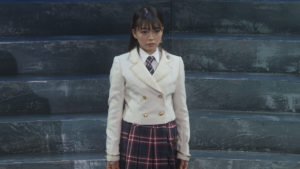 It’s then that Karen’s childhood Hikari arrives as a transfer student from a more prestigious school in London and helps save the day. Karen is thrilled to see her old friend again, but Hikari doesn’t seem to share the same enthusiasm. Eight of the nine soon receive a text message inviting them to special Revue auditions. The only one to not receive the message is the energetic but lazy Karen!
It’s then that Karen’s childhood Hikari arrives as a transfer student from a more prestigious school in London and helps save the day. Karen is thrilled to see her old friend again, but Hikari doesn’t seem to share the same enthusiasm. Eight of the nine soon receive a text message inviting them to special Revue auditions. The only one to not receive the message is the energetic but lazy Karen!
In the auditions, we see character pitted against character in one on one stage combat. Each girl transforms on stage into a military dress uniform and each uses a unique weapon from swords to daggers to even a bow to try and prove that they have more stage presence than their rival. These multiple ongoing battles are a lot of fun, and there’s some cool partially transparent panels set on wheels that are moved around the stage during this part to segment off and highlight the multiple concurrent battles. I thought this part was pretty clever and pretty well done.
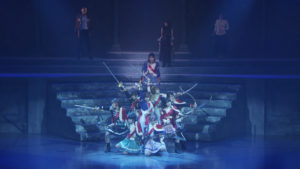 Ultimately, it’s Karen who wants to be friends with everyone who helps unify her class into working together. As partners, the girls put on one last musical combat spectacle as they work together to defeat the chorus. At the very end, the 99th class properly welcomes newcomer Hikari into their ranks, and everything ends happily.
Ultimately, it’s Karen who wants to be friends with everyone who helps unify her class into working together. As partners, the girls put on one last musical combat spectacle as they work together to defeat the chorus. At the very end, the 99th class properly welcomes newcomer Hikari into their ranks, and everything ends happily.
And then the second half of the show starts! You see, this whole event is broken up into the first half, which is a musical stage play that tells a complete story, and the second half, which is a more traditional idol style song and dance performance that’s just one song after another with no plot in between. Some of the songs are certainly catchy, and the dancing and movements are decent, there’s just not as much to say about this second half. You kinda just have to experience the songs for yourself.
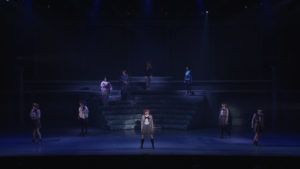 My favorite song in either half of the performance was “Watashitachi no Iru Riyuu” (The Reason We Are Here), which is actually a song that showed up a year later in the anime as “The Star Knows”. The anime version is a duet between Karen and Junna during their big Revue battle. In the stage play, it’s an ensemble song that shifts between each of the nine girls. The first half of the song is slower backed by a powerful piano and string solos. Each of the girls, in turn, sings about why they are stage girls. But, by the end, the song builds in tension and power as we learn that all the girls really have the same goal: they each want to find what makes them unique on stage. As it builds to a climax, percussion comes in and the song jumps quickly to each of the girls thoughts before unifying on them singing the same lines separately but together. It’s terrific!
My favorite song in either half of the performance was “Watashitachi no Iru Riyuu” (The Reason We Are Here), which is actually a song that showed up a year later in the anime as “The Star Knows”. The anime version is a duet between Karen and Junna during their big Revue battle. In the stage play, it’s an ensemble song that shifts between each of the nine girls. The first half of the song is slower backed by a powerful piano and string solos. Each of the girls, in turn, sings about why they are stage girls. But, by the end, the song builds in tension and power as we learn that all the girls really have the same goal: they each want to find what makes them unique on stage. As it builds to a climax, percussion comes in and the song jumps quickly to each of the girls thoughts before unifying on them singing the same lines separately but together. It’s terrific!
I like the Junna / Karen version in the anime since it’s really the first song that reveals the shape of the rest of the show, but I really, really love the song here in live action for it’s great little character moments and powerful conclusion.
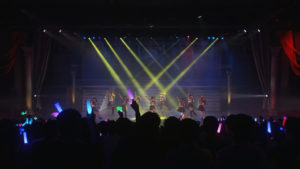 But it’s certainly not the only good song in the play. The earlier “Position Zero e!” Is a fun, upbeat number about the girls activities and goals at the music academy. “Star Divine”, which also appears in the anime as the climatic battle song, serves roughly the same purpose on the live action stage as the big number showing the girls shining together as a team. Finally, the second half of the event kicks off with an upbeat version of a fantastic song called “The Knowledge of a Stage Girl” which was later used in the anime. The animated version is a slow, happy reflection of what it means to be a stage girl. The live action version is considerably faster and more energetic and is used to get the crowd excited for the second half of the show. I like both versions a lot!
But it’s certainly not the only good song in the play. The earlier “Position Zero e!” Is a fun, upbeat number about the girls activities and goals at the music academy. “Star Divine”, which also appears in the anime as the climatic battle song, serves roughly the same purpose on the live action stage as the big number showing the girls shining together as a team. Finally, the second half of the event kicks off with an upbeat version of a fantastic song called “The Knowledge of a Stage Girl” which was later used in the anime. The animated version is a slow, happy reflection of what it means to be a stage girl. The live action version is considerably faster and more energetic and is used to get the crowd excited for the second half of the show. I like both versions a lot!
One final thing I’d like to address is what order this live action stage play and the anime should be watched in. They share a lot of similarities in characters and plot, but they are two distinct things. Ultimately, I think the anime should be watched first. Mostly, because since it has more time to tell its stories, there is more there to be spoiled. There’s a few instances in the stage play that reveal one character’s desires and those same desires play a much larger expanded role in the anime. Not knowing this character’s true desire is a key plot point of the anime, in fact. So, just for that reason alone, I’d recommend the anime first. I also liked having the anime depictions of the characters in my head as I watched the stage girls play the same parts. This isn’t so strange, I don’t think, because the anime version of each character gets a very brief appearance projected on stage during each of the live action girls’ short intros.
All In All:
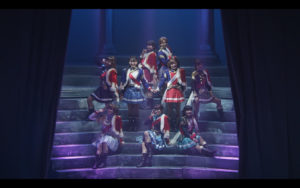 I thought the stage play was great. Each actress stuck to their character well. Each of them had something to do even if they weren’t currently under the spotlight. And, the songs often gave each character a chance to contribute and further highlight their personality. I’d probably give highest marks to the actress who had to physically embody the energetic yet timid Mahiru. Her jittery, smiley performance was very well done. The stage combat was pretty good with slashes and sword locks all supported by clanging sound effects. I’d rate this live action version of Revue Starlight a success. Its core story is somewhat different from the anime that came later, which I’ll talk about more in the Dig Deeper section, but is still strong in its own right even given the much more limited time the play had to work with.
I thought the stage play was great. Each actress stuck to their character well. Each of them had something to do even if they weren’t currently under the spotlight. And, the songs often gave each character a chance to contribute and further highlight their personality. I’d probably give highest marks to the actress who had to physically embody the energetic yet timid Mahiru. Her jittery, smiley performance was very well done. The stage combat was pretty good with slashes and sword locks all supported by clanging sound effects. I’d rate this live action version of Revue Starlight a success. Its core story is somewhat different from the anime that came later, which I’ll talk about more in the Dig Deeper section, but is still strong in its own right even given the much more limited time the play had to work with.
As Claudine Saijo might say: It was très bon!
Now that we’ve covered “was the play good and worth watching”, I’d like to dive into the specific similarities and differences between it and the anime. I’d say that the live action stage play and the anime are telling the same basic story. In both, Karen and Hikari become enamored by the play “Starlight” that they saw together as children and make a promise to one day become stars together. In both, Karen is too lazy to be invited to the Revues and Hikari transfers in devoid of passion because of a past defeat. All the other characters have extremely similar personalities and wishes and desires. The live action play has the stage girls act a little bit more antagonistic towards each other, but that’s resolved by the end of the play.
The biggest difference between the two are just how much more time the anime has to work with. Somethings that can be a quick song lyrics or lines of dialogue in the stage play are expanded to full episodes of the anime. I think it’s pretty clear that the stage play and anime were developed side by side, because those expanded storylines fit in great.
These changes do have some real impacts on the way the different stories flow:
- In the stage play, Futaba and Kaoruko’s fight is interesting because Kaoruko is pretty much in charge the entire time. She knows and recognizes that Futaba is the better stage performer so she uses her own superior acting ability to distract Futaba and get in a sucker punch of a final blow. The anime also has something of this, where Kaoruko tricks Futaba into closing the distance, but it is much more pronounced in the stage play. It’s also important to note that in the stage play, the two’s Revue battle harms their relationship somewhat, while in the anime, their Revue battle both improves Kaoruko’s work ethic and mends her relationship with Futaba.
- In the stage play, we only get one line about why Hikari returned. That maybe she’d been beaten in London and had to come crawling back. The anime shows us that entire series of events. What was a one line explanation in the stage play was turned into one of the biggest core plot points in the entire anime. That’s pretty cool.
- Likewise, the anime greatly expanded Banana’s role to the point that, really, three out of the twelve episodes focus on her while she was just a minor character in the stage play. Hearing live action Banana sing about not wanting to grow up and wishing time would stand still is actually pretty chilling coming from the anime where she straight up put her entire class, if not the entire world, into a time loop specifically so she could relive her class’ first performance of Starlight. Banana planning on repeating the loop is so well integrated into even the early episodes of the anime that I think it would be a shame to tip viewers off with some of the things she sings about in the stage play.
- Finally, any school staff we see in the anime are completely unaware of the Revues, but in the stage play the head of the academy is under orders from the giraffe to pit the girls against one another. This makes even the giraffe a more malevolent character than he is in the anime. He also only appears at the end of the stage play, so he’s quite a bit more mysterious, as well.
I think it’s great to have both versions of the story. It’s great to see a single good story told in different ways that are remolded to better support the medium they are being told in.